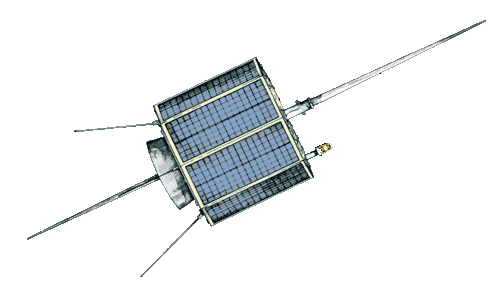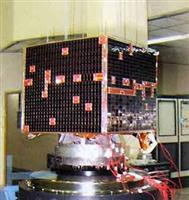Southgate News links to another possible geosynchronous amateur satellite. Like buses, we see none and then lots! As HF conditions deteriorate, geosync satellites could prove very useful. The footprint just reaches the UK. 10GHz download.
See http://www.southgatearc.org/news/2016/october/a-geosync-ham-radio-satellite.htm .
See also https://amsat-uk.org/satellites/geosynchronous/na-gso-sat/ .
Showing posts with label satellite. Show all posts
Showing posts with label satellite. Show all posts
17 Oct 2016
26 Aug 2016
Amateur Satellites
Next year, if all goes to plan, we may have an amateur satellite in a geosynchronous orbit permitting long distance propagation at almost any time day or night. As the solar activity declines, this could be a lifeline. I have little experience of amateur satellites and only had a single QSO via a low orbit satellite. Geosynchronous should mean lower Doppler and hours of operation whereas low orbit satellites go out of range within 20 minutes. Years ago I recall the excitement of hearing US and Canadians on Oscar 6 and 7 on 2m. Being on microwave bands should mean much greater transponder bandwidths. Also, dishes can be fixed as the satellite will always be in the same place in the sky like a TV satellite.
Labels:
satellite
22 Jul 2016
Geostationary amateur satellite
If all goes to plan we could have a new 13cm and 3cm transponding geostationary satellite in place next spring. Being fixed in position, Doppler should be no issue. I guess the date is a problem (these often slip) and getting it successfully in the right place and operational is in some doubt. With declining solar conditions, this could be just what we need. Of course, the dish can be fixed.
See https://amsat-uk.org/2016/06/24/phase-4a-geostationary-transponders/ .
I picked this up on the Southgate News page.
See https://amsat-uk.org/2016/06/24/phase-4a-geostationary-transponders/ .
I picked this up on the Southgate News page.
1 Apr 2016
Satellite collision
See http://www.amateurradio.com/ao-73-funcube-and-ao-85-fox-1-satellites-collide/#comment-156869
Note the date of this post.
Note the date of this post.
Labels:
satellite
30 Dec 2015
Amateur satellites
See http://www.southgatearc.org/news/2015/december/another_eo79_transponder_activation.htm .
It is some years ago that I successfully had a QSO through an amateur satellite. Our hobby is filled with variety and it is simply not possible to do everything. This is one of the great things about amateur radio: there are so many ways to enjoy the hobby. EO79 is just one of many transponding satellites.
It is some years ago that I successfully had a QSO through an amateur satellite. Our hobby is filled with variety and it is simply not possible to do everything. This is one of the great things about amateur radio: there are so many ways to enjoy the hobby. EO79 is just one of many transponding satellites.
Labels:
satellite
29 Sept 2015
Processing weather satellite images
This is not my thing but others may find this of interest if you enjoy weather satellite images. I am content to put seaweed out the window here or even watch the BBC weather! The latter seems only to be correct if we have a long settled period here in the UK. So, you do as well looking out of the window.
See http://www.satsignal.eu/ .
See http://www.satsignal.eu/ .
4 Apr 2014
Oscar 6 and 7
 | ||
| http://ukamsat.files.wordpress.com/2012/06/oscar-7-amateur-radio-satellite.gif?w=593 |
Many years ago when I lived in Cambridge I recall listening for the 2m transponder outputs from thse satellites at the topmost end of the band. Using my "Oscarlator" - a paper based calculator one could predict passes in range. The best ones were late at night way out west over the Atlantic, when, for a few minutes Ws and VEs could be heard. Also copyable was HB9HB, a 70cms beacon that got translated to 2m. I never transmitted via satellites then and used a homemade 2m converter feeding an old T28 Codar receiver. Happy days back in the 1970s. I gather Oscar 7 is still up and (sort of) functioning.
See http://www.qsl.net/pe1rah/oscarlator.htm .
3 Apr 2014
Amateur satellites
I have only ever had one single SSB contact via an amateur satellite and that was one with a 29MHz downlink many years ago. I cannot recall the satellite or the uplink frequency. I have not bothered since but don't doubt I could have QSOs with a 70cm/2m transponder. I see from the Southgate amateur radio news pages that the transponder on the FUNcube-1 satellite is to be switched on tomorrow for the weekend.
10 May 2010
Japanese Hamsat off to Venus
On May 17 Japan's Space Agency plans to launch a mission to Venus. It will also be carrying a 35cm cubed nano-satellite developed by universities and colleges. This nano-satellite will go into a Venus encounter trajectory and will become the world first university satellite which goes beyond the moon. It will perform technology experiments and test long-range, inter-planetary communication using amateur radio frequencies:
Downlink Frequency: 5840.000MHz, band width 20MHz
Transmission Power: 4.8W/antenna, 9.6W total
Antenna: 2 Microstrip patch antennas
Modulation: AFSK/FM 1200bps during LEO flight
CW 1bps during Interplanetary flight
18 Jan 2010
Want to launch your own satellite? You can!
 Interorbital Systems of California have introduced a kit to allow you to build your own satellite! The price of the Tubesat kit ($8000) includes the cost of a launch into space as well.
Interorbital Systems of California have introduced a kit to allow you to build your own satellite! The price of the Tubesat kit ($8000) includes the cost of a launch into space as well.
1 Dec 2008
VO-52 satellite reception
 Not listened for amateur satellites for some time so took a quick listen on 2m SSB around 145.9 this evening. Managed to catch a couple of VO-52 satellite passes and logged IK1SOW, EB2FJN, SP4BY and HB9XJ on SSB. I have printed out the passes for the next few days so will see what else I can receive on the FT817 and the vertical colinear antenna.
Not listened for amateur satellites for some time so took a quick listen on 2m SSB around 145.9 this evening. Managed to catch a couple of VO-52 satellite passes and logged IK1SOW, EB2FJN, SP4BY and HB9XJ on SSB. I have printed out the passes for the next few days so will see what else I can receive on the FT817 and the vertical colinear antenna.The first place to check for first-time satellite SWLs is the AMSAT page which has lots of helpful info on satellites, frequencies and passes.
Subscribe to:
Posts (Atom)


